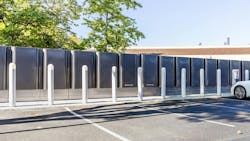Bloom Energy Expands Fuel Cell Power Generation for Intel's Santa Clara Data Center
Increasing your data center’s power demand, especially when that data center is in power-strapped California, is a process that can require dealing with issues from power transmission to the simple availability of additional power at the required location.
For Intel’s high-performance data center in Santa Clara, the answer became clear: expand on their existing, at least aspirationally hydrogen-compatible fuel cell infrastructure, as currently powered by natural gas.
Additional Megawatts for Hyperscale Expansion
A decade ago Intel invested in a reported 6.5 MW of Bloom Energy fuel cell power for the data center campus.
Yesterday's announcement of the power capacity agreement doesn’t give specific details on the additional capacity being added, with the new capacity being reported as “additional megawatts,” via a system which will adopt hydrogen "when it becomes economically viable."
Bloom’s lead product right now is their Series 10 solution, which is designed to use the Bloom Energy Bloom Boxes to provide up to 10 MW of power with 99.99% uptime, and to be available to customers in an abbreviated 50 day timeframe.
At the announcement, Shesha Krishnapura, Intel Fellow, and Intel IT Chief Technology Officer, stated:
"Intel HPC Data Center infrastructure currently powers 400,000+ Intel Xeon-based servers (5+ million highest clock cores), 700+ petabytes of storage, and 800,000+ network ports. To meet additional HPC scale needed for Intel Products and Intel Foundry, Intel is leveraging Bloom Energy technology to power the next data center expansion."
Krishnapura added, "Intel is leading the industry in extreme energy-efficient high-performance computing data centers with its existing hyperscale Intel Santa Clara Data Center operating at 1.06 [!] PUE.”
The HPC data center is used for complex Intel chip design and technology development.
How Is the Power Produced?
Most people tend to think of hydrogen fuel cells which are topped up with liquid hydrogen when they think about such technology.
Bloom Energy, one of the pioneers in the hydrogen fuel cell industry, uses solid oxide fuel cells, which operate at a higher temperature and convert natural gas, biogas, or hydrogen into electricity with no burning and low or no CO2 emissions.
The fuel cells can be used in concert with grid power or as their own microgrid power source.
Energy is provided 24/7 and the solution is designed as a primary power generation installation - not as a small scale backup power source, as with many of Bloom’s competitors.
Ravi Prasher, Bloom Energy’s Chief Technology Officer, pointed out:
"Bloom Energy technology is compatible with hydrogen fuel in addition to natural gas. We are working with governments and industries to adopt hydrogen as a primary fuel when it becomes economically viable. Intel’s confidence in our fuel cell technology is a testament to Bloom’s ability to reliably meet the energy needs of cutting edge and high-performance IT infrastructure."
As of July 2023, Bloom acknowledged that they had installed over 1 GW of clean power.
The total deployment is not at data centers alone, as Bloom is also deployed in industrial applications, hospitals, and retail, among other industry deployments.
Released in March 2024, the following video describes Bloom Energy's load following power technology for AI data centers.
About the Author



